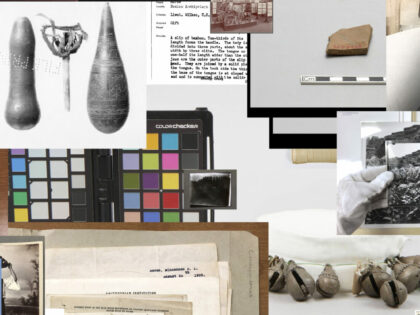Squeak Carnwath
Full Time 2003

Art © Squeak Carnwath/Licensed by VAGA, New York, NY. Reproduction of this image, including downloading, is prohibited.
Audio Description (04:47)
Full Audio Transcript (Expand)
Full Time
Full Time by Squeak Carnwath was made in 2003 by painting oil on canvas attached to a panel. It is just a little bit over six feet tall by six feet wide. At first glance, the painting is a hodgepodge of shapes, words, scribbles, and layers that seem unrelated. The more time you spend with it, the more it grows to feel like these might be part of a secret code hidden within the painting.
The background layers are white and beige, often applied in splotches. An uncentered, mint green rectangle takes up much of the canvas, and enclosed within it are images and words in black, yellow, orange, red, gray, brown, baby blue, and mint and gray greens. Above the mint green rectangle, going all the way across the top are a few rows of cursive handwriting. Though the handwriting is in dark paint, it has been covered over by gauzy layers of white, leaving it mysterious and impossible to decipher. Separating this portion from the top of the mint green rectangle is a chain of thin white loops like lace. The right edge of the painting has three nearly straight, but imprecise stripes from top to bottom, gray-green, rusty red, then dark blue, with much of the gray-green and some of the red stripe covered by the right edge of the mint green rectangle. The bottom edge of the painting has 13 shapes in dark blue, unevenly spaced and shaped like fat little Christmas trees. The tops of these shapes are partially covered over by the bottom border of the mint green rectangle. The left edge of the rectangle is situated at the left edge of the canvas.
Now let’s explore what lies within the mint green rectangle. Scattered around the space are nearly perfect circles, some filled with red, mint green, yellow, or white, and others only faint outlines. A few appear to be peeking out from the mint green border while others float freely like bubbles. In the upper left, giant lowercase gray-green cursive spells out “all time.” Below that is a smear of orange and a yellow outline in the shape of a chocolate Easter bunny with “dumb” written in small letters on its chest.
By the bunny’s upright ears is a white rectangle painted like loose leaf notebook paper with pale blue lines for writing on and a double red line down the left side to indicate the left margin. Freeform handwriting in gray green is a mix of uppercase and lowercase that refuses to always stay against the red margin. The first line of most of the sentences rests against the margin lines while others move to the left of it or sit right on it. The page reads, “Memory is not accurate recall. We remember what we want. What we choose. Our present moment influences our memory of the past. We remember what we want. We make it real by writing our own history. The one tattooed in our mind’s memory.”
Outside the loose leaf paper, there are scribbly thin lines, big and small dots, drips, and smears of paint, a print of a tree stump, and below it, in mostly uppercase letters, “Life is a full time job” painted with the words slowly drifting lower until the “b” in “job” sits on the bottom mint green border.
The last image within the mint green rectangle that stands out is the “guilt free zone” with those words painted in a pinky beige that nearly blends in with the beige background. The zone is marked by a circle of dark black dashes. Within that circle is a hand painted portion of a map of West Oakland, the lines uneven as if the brush were sometimes running out of paint at random points while making the streets. An estuary and West Embarcadero are at the bottom, then a small grid of streets somewhat painted over by gray, and 14th near the top, with unnamed streets poking out of it like antennae. Oak Street is the last named street on the right, which crosses a left-right black line labeled “freeway.” The left edge of the map has a painted line named only “another freeway.”
On closer inspection, more writing and shapes can be found in a tan color that look as if they were carved into the paint rather than applied with a brush. They are faint and difficult to make out, though with the presence of a guilt free zone, one may not feel so bad about not being able to crack all of the code hidden here.
Redefining Feminism in Modern Art
Full Time demands our sustained attention. It is full, almost overwhelmingly so, of symbols, words, and scribbled forms. The more you look, the more you see, and the more you’re driven to decipher. Carnwath’s unique symbolism and iconography are derived from her lived experience: her experiences with family, being an artist, and societal pressures. Most of these symbols sit in contrast and chaos with one another, with the Guilt Free Zone metaphorically arching over them.
In this chaos, Carnwath plays with the believability of painting, using her practice as a form of questioning and processing. To the artist, paintings are living bodies, in their countless layers and elasticity of representation, defying rationalization while remaining familiar. Full Time helps us reflect on the nature of reality, illusion, and experience by incorporating them all into one.
—Irmak Ersoz ‘24







